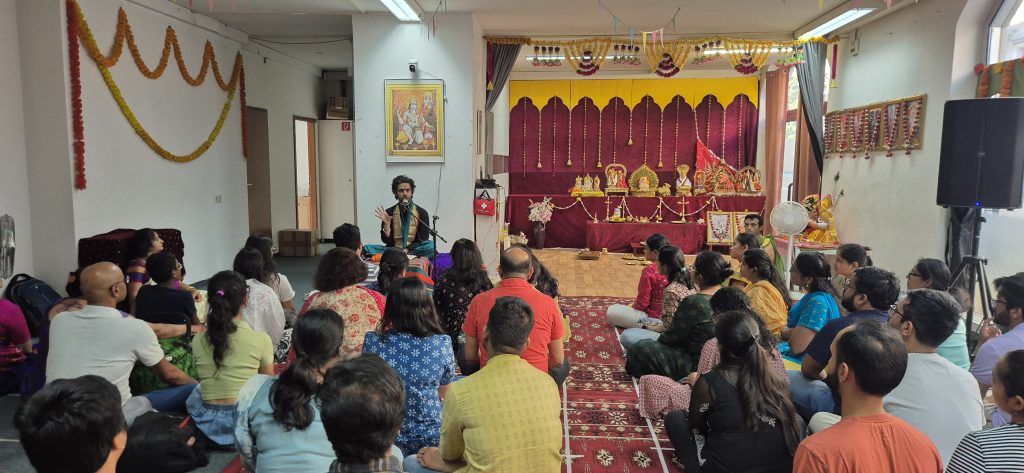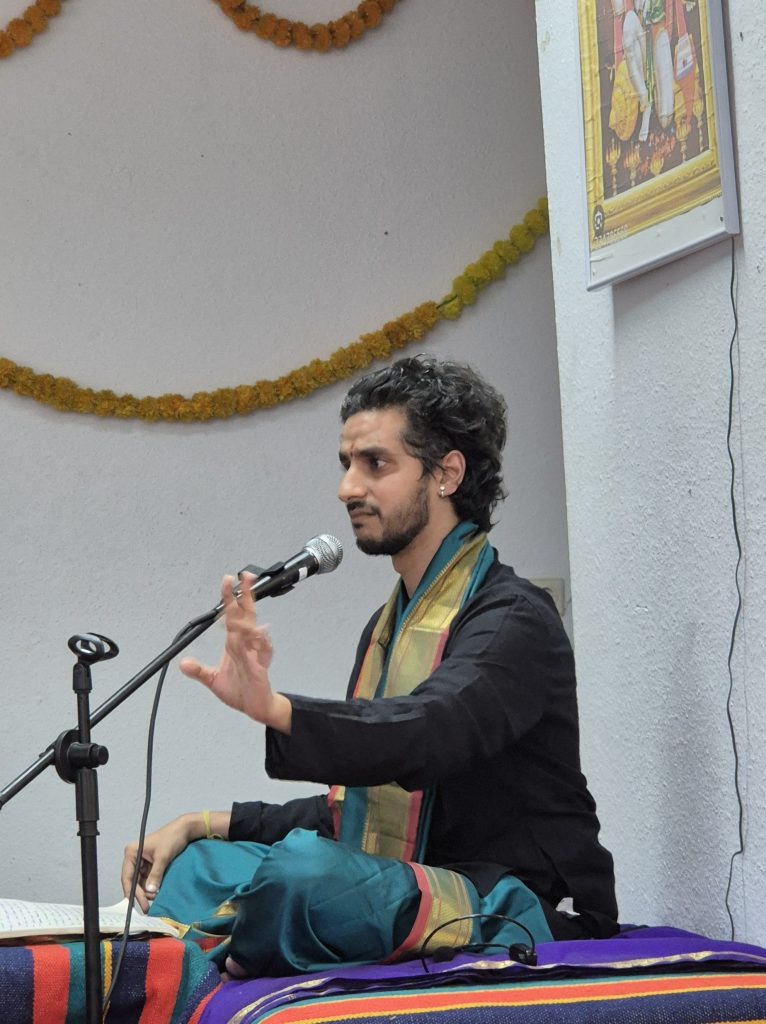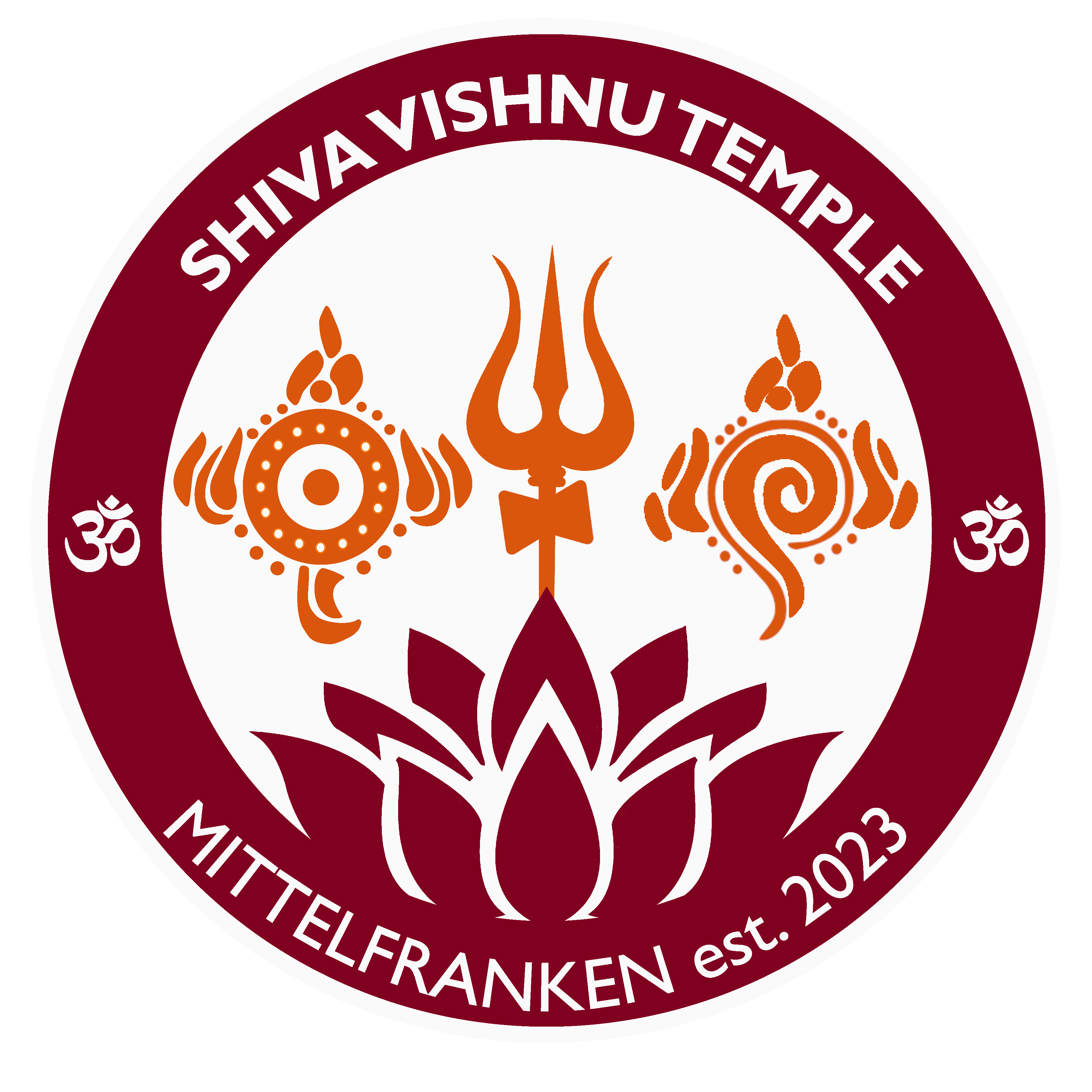
On a hot summer evening in Fürth, Germany, the air was charged with an unmistakable energy. Your Shiva Vishnu Temple welcomed over a hundred eager seekers, spiritual enthusiasts, and lovers of stories that transcend time and space. Despite disrupted train schedules, devotees poured in from places as far-flung as Prague and Hamburg. Why? To attend a very special discourse by the renowned storyteller and speaker Vinay Varanasi, on the profound and eternal relationship between Shiva and Vishnu in their many forms and avatars.
What unfolded over the next few hours wasn’t just an event—it was a journey across cosmic landscapes and puranic marvels, woven together with love, wisdom, humor, and devotion.
Setting the Scene: Rituals, Anticipation, and Community
The evening began, as any auspicious Hindu gathering does, with the Nitya Puja—a daily worship ritual offered to the temple deities. The familiar sounds of ringing bells, Sanskrit chants, and the fragrance of sandalwood and incense welcomed every guest.
The temple hall, though modest in size, pulsed with warmth. Young and old sat side by side, some with children on their laps, others taking notes—eyes wide, hearts open.
Vinay Varanasi: The Master Storyteller
As Vinay Varanasi took the microphone, he brought not only his erudition but also his unique gift of narration. He didn’t lecture—he invited, he interacted. And with every word, he beckoned the audience into a realm where deities walk among us, and ancient stories still echo in our souls.
The discourse spanned nearly two hours, yet time seemed suspended. From lofty metaphysical concepts to relatable anecdotes, Vinay seamlessly carried listeners through the labyrinth of divine relationships, especially between Shiva and Vishnu, and the avatars that incarnated their essence.

Stories that Stirred the Soul
1. Krishna and the Sanyasi: Shiva’s Longing for the Divine Child
In the village of Gokul, a mysterious Sanyasi arrived at Yashoda’s doorstep, asking to hold baby Krishna. Though hesitant at first—wary of his intense aura—Yashoda eventually relented. What she didn’t know was that the Sanyasi was Lord Shiva in disguise, yearning for a moment with the divine child. When he finally held Krishna in his arms, tears of bliss flowed freely, his longing fulfilled in that single embrace.
Vinay presented this tale not just as a charming vignette but as a metaphor: even the gods long for connection. Shiva, the great ascetic who renounces all, still finds joy and fulfillment in the innocence of Krishna. It’s a reminder that spirituality isn’t aloof—it yearns, feels, and flows toward love.
2. Sati and the Daksha Yajna: Pain, Protest, and Cosmic Redemption
The story of Sati, Shiva’s consort, and her tragic end at the Daksha Yajna was retold with piercing emotion. When Sati immolates herself due to her father’s insult toward Shiva, it sets off a cosmic chain reaction—Shiva’s grief turns to rage, and from that destruction arises the mystical truth of Shakti Peethas.
Vinay highlighted how Sati’s body falls across 51 sacred spots across the Indian subcontinent. These sites, known as Shaktipeethas, aren’t just geographical—they correspond to the 51 letters of the Sanskrit alphabet. In this poetic symmetry, language and spirituality become one. Sanskrit isn’t just a tongue—it’s the embodiment of divine presence.
3. Manikarnika Ghats and the Whispered Liberation
Of all the stories Vinay shared, one in particular left the audience in awe. He spoke of the Manikarnika Ghats, Varanasi’s sacred cremation ground. According to tradition, Lord Shiva himself whispers the Rama Taraka Mantra into the ear of those who die there, granting them liberation (moksha).
In this tale, the terrifying and the tender co-exist. The destroyer of worlds becomes the whisperer of salvation. It reminded everyone that Shiva is not only the cosmic dissolver but also the compassionate guide through the cycle of life and death.
A Community Strengthened Across Borders
After the discourse, a brief Q&A session followed. Questions flowed freely—from theological nuances to personal reflections. Given a chance, the devotees would have merrily asked questions till midnight. But, we had to let the curtains come down.
Though travel disruptions kept some guests away, the dedication of those who made the journey was palpable. It wasn’t just locals—the draw of this event crossed borders. People from across Bayern, Hamburg, Prague, and other distant cities gathered not just for knowledge, but connection.
The Shiva Vishnu Temple turned into more than a physical space—it became a hub of shared spirituality, a sanctuary where stories aren’t just told, but lived.
Prasadam and Parting Smiles
As the sun dipped below the horizon and the temple lights glowed softly, the evening ended with the distribution of Prasadam. It wasn’t lavish, but it was deeply satisfying. Sharing a meal together after soaking in such spiritual nourishment felt poetic.
Reflections: Why This Evening Mattered
Why do such events matter? In the midst of busy routines, worldly distractions, and emotional upheavals, evenings like this remind us of something deeper—our rootedness in stories, our yearning for meaning, and our capacity to transcend borders through faith.
Vinay Varanasi’s discourse wasn’t just about Shiva and Vishnu. It was about how opposites meet, how sacred relationships unfold in both divine realms and our human lives. Whether it’s the balance of creation and destruction, the dance between order and chaos, or the love between cosmic beings, these stories speak to timeless truths.
Shiva and Vishnu are often portrayed as distinct—one meditating in solitude, the other preserving the universe. But through Vinay’s lens, they emerge not as competitors but complementary forces. Their bond isn’t one of contrast, but convergence.
It’s a powerful lesson for our times: That cooperation, respect, and humility can exist even between the greatest powers imaginable. And if that’s true in the cosmos, how much more should it be true in our communities, homes, and relationships?
Om Namo Naarayanaaya! Om NamahShivaaya!



Leave a Reply